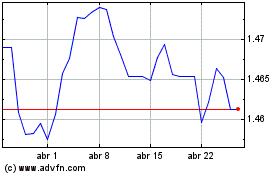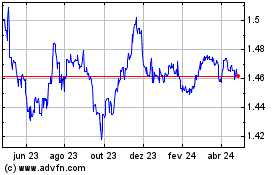Commodity Currencies Fall As Oil Prices Slide
29 Outubro 2024 - 1:26AM
RTTF2
The commodity currencies such as Australia, the New Zealand and
the Canadian dollars weakened against their major currencies in the
Asian session on Tuesday, as crude oil prices fell amid rising
geopolitical tensions in the Middle East.
Crude oil prices fell sharply as concerns about supply
disruptions faded after Israel avoided hitting Iranian oil
facilities over the weekend. West Texas Intermediate Crude oil
futures for December plunged $4.40 or 6.1 percent at $67.38 a
barrel.
The Brent crude for December, the worldwide benchmark, fell
$4.63, or 6.1%, to $71.42 a barrel. This was the biggest daily
percentage decline since July 2022.
Traders remain cautious ahead of the release of key U.S.
economic data later in the week that could impact the expectations
regarding how quickly the U.S. Fed will lower interest rates.
The monthly jobs report, consumer confidence, pending home
sales, manufacturing sector activity, third quarter GDP as well as
a report on personal income and spending that includes the Fed's
preferred inflation readings are likely to be in the spotlight this
week.
While the Fed is widely expected to lower interest rates by
another quarter point next month, CME Group's FedWatch Tool
currently indicating a nearly 30 percent chance the central bank
will leave rates unchanged in December.
Weakness in energy stocks amid tumbling crude oil prices, also
led to the downturn of the commodity-linked currencies.
In the Asian trading now, the Australian dollar fell to nearly a
3-month low of 0.6561 against the U.S. dollar and nearly a 2-week
low of 1.0988 against the NZ dollar, from yesterday's closing
quotes of 0.6583 and 1.1005, respectively. The aussie may test
support around 0.63 against the greenback and 1.08 against the
kiwi.
The aussie slid to a 1-week low of 100.27 against the yen, from
yesterday's closing value of 100.90. On the downside, 97.00 is seen
as the next support level for the aussie.
Against the euro and the Canadian dollar, the aussie dropped to
near 1-1/2-month lows of 1.6475 and 0.9119 from Monday's closing
quotes of 1.6422 and 0.9143, respectively. If the aussie extends
its downtrend, it is likely to find support around 1.67 against the
euro and 0.90 against the loonie.
The NZ dollar fell to 0.5968 against the U.S. dollar and 91.23
against the yen, from yesterday's closing quotes of 0.5980 and
91.65, respectively. If the kiwi extends its downtrend, it is
likely to find support around 0.58 against the greenback and 88.00
against the yen.
Against the euro, the kiwi edged down to 1.8111 from Monday's
closing value of 1.8074. The kiwi may test support around the 1.86
region.
The Canadian dollar fell to 1.3901 against the U.S. dollar and
109.92 against the yen, from yesterday's closing quotes of 1.3889
and 110.35, respectively. If the loonie extends its downtrend, it
is likely to find support around 1.40 against the greenback and
102.00 against the yen
Against the euro, the loonie edged down to 1.5028 from Monday's
closing value of 1.5017. The next possible support level for the
loonie is seen around the 1.52 region.
Looking ahead, U.K. mortgage approvals data for September are
due to be released in the European session.
In the New York session, Canada wholesale sales data for
September, U.S. wholesale and retail inventories for September,
U.S. Redbook report, U.S. S&P/Case -Shiller home price index
for August, U.S. Consumer Board's consumer confidence for October
and U.S. Dallas Fed services index for October are slated for
release.
Euro vs CAD (FX:EURCAD)
Gráfico Histórico de Câmbio
De Out 2024 até Nov 2024

Euro vs CAD (FX:EURCAD)
Gráfico Histórico de Câmbio
De Nov 2023 até Nov 2024
